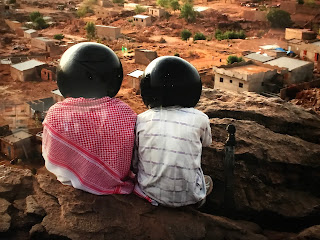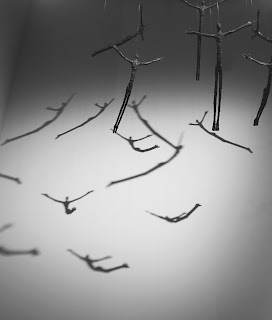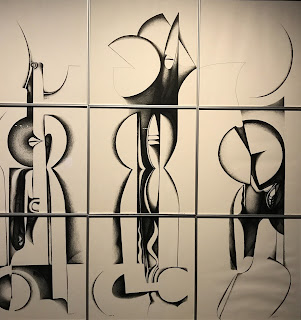IT WAS NOT MY INTENTION...
I had no intention of writing a blog chapter for this exhibition.In actual fact, it wasn’t on my list. Sunday dawned grey and cold so instead of curling up in a chair, I pushed myself out to see:-
"From Timbuktu to Zanzibar - The Islamic Treasures of Africa" : 13 centuries of African Subsahran Islamic History
Here is the description given on the Institute’s English home page:-
If you were really to write a chapter on this subject, it would take years of research. Each African country seemed to have their own interpretation of the Muslim Culture and although I cannot be sure, it also looked from the books and the tablets that the Coran or Qur’an also different from region to region. For once, I did read the texts referring to Islam and the different descriptions of objects, implements, etc. used by both men and woman. I knew though that I was certainly not in a position to comment on 13 centuries of African Subsahran Islamic History…
From Dakar to Zanzibar, and from Timbuktu to Harar, the Arab World Institute (Institut du monde arabe) is highlighting African communities that have benefited from thirteen centuries of spiritual and cultural exchange with the Maghrib and the Middle East. Focusing on archaeology, architecture, immaterial heritage, and contemporary art, this unprecedented exhibition brings together around 300 multidisciplinary works in an exhibition space of 1,100 m2 in order to highlight the cultural and artistic richness of the Islamic communities in sub-Saharan Africa.
The first part of the itinerary takes visitors through the ages, because Islam began to spread in in sub-Saharan Africa in the eighth century. The Sahara became a key area for trade and travel. Thanks to the trade and communication networks, there were three distinct areas with a shared history and artistic forms: the Horn of Africa and the Nile valley, the Swahili area, and West Africa. How did—and how does—Islam express itself in these regions?
The second part of the exhibition immerses the visitor in the religious architecture, the religious practices, and magic. Immersive videos of ceremonies take the visitor into the heart of Sufi spirituality in Africa.
The transmission of the Arab-Muslim culture is also evident in the art and craftsmanship. The ‘Islamic Treasures of Africa’ exhibition concludes with a presentation of powerful works, while highlighting the dissemination of artistic forms and know-how across the continent and their contribution to the promotion of Islamic culture in Africa. Embroidered boubous, silver jewellery, amulets, and Tuareg leather goods attest to the burgeoning creativity of the Muslim craftsmen.
Writing—the exhibition’s common theme—enabled the dissemination of the sacred texts. It was also used in magic and attests to the regional characteristics of the calligraphy in Africa.
Contemporary art is showcased throughout the exhibition in order to analyse the history of the cultural exchange. Major artists such as Hassan Musa, Abdulaye Konaté, Youssef Limoud, and Aida Muluneh are prime examples of the effervescence in the contemporary artistic scene in Africa.
It was this series of three photos which stopped me fast in my tracks.
 |
| Inch'Allah Aboubacar Traoré 2016 |
 |
| Inch'Allah Aboubacar Traoré 2016 |
 |
The three photos are part of a series that display the religious indoctrination by radical Islamists. From teaching to abuse. In reaction to the political situation in Mali since 2012, the artist-photographer, Aboubacar Traoré denounces the vulnerability of young people to recruitment. The faces are covered by helmets symbolising their lack of critical thinking. You can see how young these people seem to be. Their hands for instance. Frankly, I was taken back…
Then I came upon this huge photo. The artist in question, Maimouna Guerresi converted to Sufi Islam in Senegal. Then she then joined a Sufi brotherhood. Those you see in the photos are wearing minarets made from simple materials. These bodily extensions are supposed to transmit spiritual energy. If the people hide their faces as some do, it is to remove themselves from the real world and approach the divine. They look so high and that little girl who is showing her face, looks so vulnerable.
 |
| Maimouna Guerresi ORANGE AND YELLOW MINARET -2011-2012 |
Nom de Dieu is composed of two divine sayings from the Qur’an.
There is no compulsion in religion. The right direction is henceforth distinct from error (Surah ll,256)In mirroring these two versus, the first encourages Muslims to enter into dialogue and the other holy war. If you read the texts in the exhibition it’s easy to see that for many centuries Islam was transmitted in an atmosphere of tolerance and respect for secular traditions. The contemporary situation that we know today does not necessarily express the same situation.
But if they turn back, then seize them and kill them wherever you find them » (Surah lV:89)
These two done on paper and then onto canvas are really striking. Babacar Diouf’s calligraphic symbols are inspired by several forms of writing…the discipline to do such work must require a skill that is akin to an ascetic exercise. One seems to be done entirely with musical notes and the other with different symbols or different writing…
 |
| MYBAYE BABACAR DIOUF |
 |
| MYBAYE BABACAR DIOUF |
 |
 |
This was a whole wall of different hieroglyphics. Even I could see the many ways of designing a letter of a form…
Then these figures flying in the wind…The artist is Ndary Lo. The work is done with recuperated materials and of course, iron. Are they extending their arms in a gesture of prayer or flying toward the divine?
 |
| NDARY LO - 2015 |
 |
| NDARY LO - 2015 |
This work by Cheikh Admadou Bamba is very naive. The themes represented are images of tales and stories that depict episodes from the life of the saint. I would think that the stories are very accessible to the viewer…
A small video caught my attention but only because of this image…street art photographed by three Senegalese artists and represent extracts from a work called « A Saint in the City: Sufi Arts of Senegal » 2003. It is very strong is it not?
Najia Mehadji- the colour symbolises the spirit of the forest (in the Gnawa trance).
 |
| Najia Mehadji - 2015 |
I didn’t stop long to watch the videos. There was a repetition of movements rather like convolutions and my head started swimming when I watched one tribal member moving his body up and down for what seemed like a very long time…
Would you believe that this is a mask? A Bedu mask from the Ivory Coast (19th-20th century).
 |
| Bedu Mask - The Ivory Coast XIX-XX |
This too is strange. A talismanic Tunic from West Africa. The pieces are supposed to be magic even if they are collected from waste.
 |
| Talismanique unic 1950-2000 : West Africa |
Another talismanic Tunic but this one is based on the repetition of a Qur’anic formula about love. It’s meaning has been altered to meet the needs of the client who wished to win popular support. I would suppose of great help during electoral periods!
 |
| Visible writing on a talismanic tunic - West Africa - 1950-2000 |

I know this hand was done in Alep but I didn’t find the description for it.

 An installation caught my attention which is not usually the case as you know. But it didn’t seem to be anything in particular. It was created on the spot by the artist while the exhibition was being installed and will disappear at the end. All the pieces are inspired by childhood, desert and the dust of the dead and many of the pieces too have magical power…I didn’t see or feel any when I was standing there…it is called « On the Dust of Myth » and by Youssef Limoud.
An installation caught my attention which is not usually the case as you know. But it didn’t seem to be anything in particular. It was created on the spot by the artist while the exhibition was being installed and will disappear at the end. All the pieces are inspired by childhood, desert and the dust of the dead and many of the pieces too have magical power…I didn’t see or feel any when I was standing there…it is called « On the Dust of Myth » and by Youssef Limoud.
Once again a mask made by the young men from the Baga people. It first appeared at the beginning of the 20th century. The iconography is of the Prophet’s mount which spread from the Near East to West Africa. They are worn during specific celebrations.

I love this but didn’t see the description until I came home and saw it in tiny lettering on the side of the toy(?)

Quite beautiful pheasants from Senegal. They are painted on glass and belong to the 20th century.
 |
| The centre enlarged |
 Now from Cameroun a sheet embroidery representing the al Burâq (1950-2000).
Now from Cameroun a sheet embroidery representing the al Burâq (1950-2000). There were two photos side by side but I only chose this one. They say it is a photo of two men wearing traditional Muslim clothing. They are posing in a reasonably relaxed way but very proud too. The photographer is Seydou Keïta (1955-57).
 |
| Seydou Keïta : Mali 1956-57 |
 A very large installation and also extremely striking. Victor Ekpuk was inspired by various forms of writing which gave him the possibility to invent a new calligraphic style. You can even see that it is a man and woman and are they ensuring the stability of the world? I would like to think so.
A very large installation and also extremely striking. Victor Ekpuk was inspired by various forms of writing which gave him the possibility to invent a new calligraphic style. You can even see that it is a man and woman and are they ensuring the stability of the world? I would like to think so. Once again diverse calligraphic forms from Saharan African manuscripts. They are composed on loose sheets…like me, are you beginning to see the momentous number of different writing?
The blue medallions placed on either side of the central decor have the power to transmit the baraka or divine blessing to whoever touches it…you can just see it at the end when the spectator comes back....
 |
Here are some diverse calligraphic forms. They are composed of loose sheets in a sleeve. They come from Mauritania to Chad...
 |
| Aida Muluneh - City Life - 2016 |
Finally a rather strong photo taken by Aida Muluneh in 2013. He paints the body of his models inspired by the Body Art practised throughout the African continent. The costumes are designed in collaboration with fashion designers…what a proud creature.
I looked down at my watch and gasped. I had been wandering through this maze of history for nearly three hours. So many photographs of jewellery, head dresses, costumes that I did not take. Perhaps simply because I had see so many before. All this was new to me and seeing the immense diversity of Muslim in the African countries made me feel that I knew a tiny, tiny bit more about these people.








Commentaires